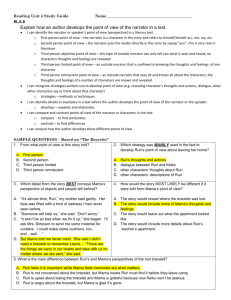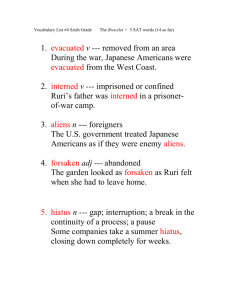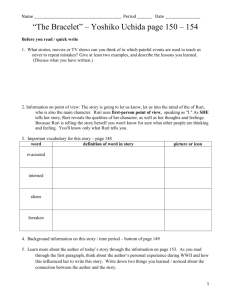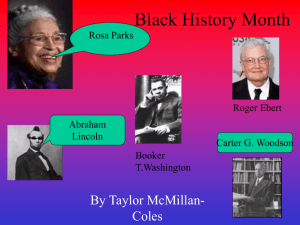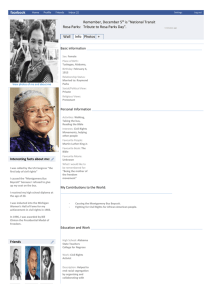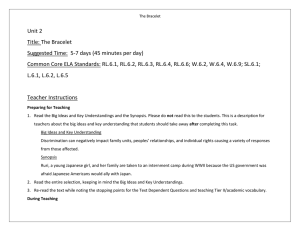Unit 3 “Stories of Change” Name Reading Study Guide RL.6.5
advertisement
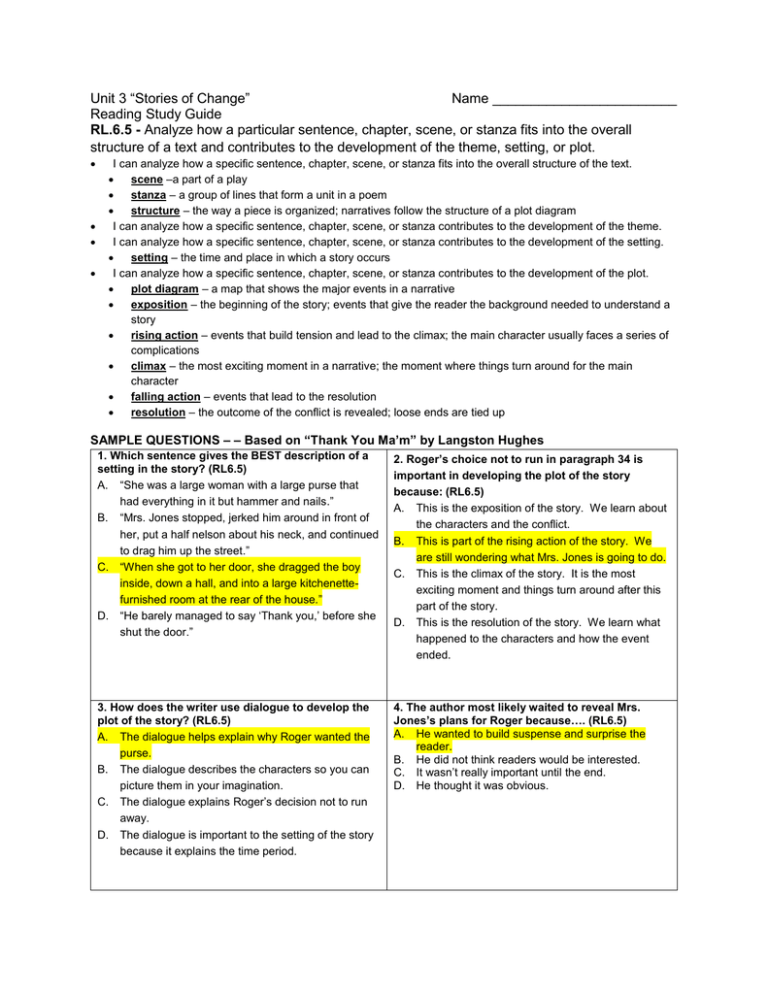
Unit 3 “Stories of Change” Name ________________________ Reading Study Guide RL.6.5 - Analyze how a particular sentence, chapter, scene, or stanza fits into the overall structure of a text and contributes to the development of the theme, setting, or plot. I can analyze how a specific sentence, chapter, scene, or stanza fits into the overall structure of the text. scene –a part of a play stanza – a group of lines that form a unit in a poem structure – the way a piece is organized; narratives follow the structure of a plot diagram I can analyze how a specific sentence, chapter, scene, or stanza contributes to the development of the theme. I can analyze how a specific sentence, chapter, scene, or stanza contributes to the development of the setting. setting – the time and place in which a story occurs I can analyze how a specific sentence, chapter, scene, or stanza contributes to the development of the plot. plot diagram – a map that shows the major events in a narrative exposition – the beginning of the story; events that give the reader the background needed to understand a story rising action – events that build tension and lead to the climax; the main character usually faces a series of complications climax – the most exciting moment in a narrative; the moment where things turn around for the main character falling action – events that lead to the resolution resolution – the outcome of the conflict is revealed; loose ends are tied up SAMPLE QUESTIONS – – Based on “Thank You Ma’m” by Langston Hughes 1. Which sentence gives the BEST description of a setting in the story? (RL6.5) A. “She was a large woman with a large purse that had everything in it but hammer and nails.” B. “Mrs. Jones stopped, jerked him around in front of her, put a half nelson about his neck, and continued to drag him up the street.” C. “When she got to her door, she dragged the boy inside, down a hall, and into a large kitchenettefurnished room at the rear of the house.” D. “He barely managed to say ‘Thank you,’ before she shut the door.” 2. Roger’s choice not to run in paragraph 34 is important in developing the plot of the story because: (RL6.5) A. This is the exposition of the story. We learn about the characters and the conflict. B. This is part of the rising action of the story. We are still wondering what Mrs. Jones is going to do. C. This is the climax of the story. It is the most exciting moment and things turn around after this part of the story. D. This is the resolution of the story. We learn what happened to the characters and how the event ended. 3. How does the writer use dialogue to develop the plot of the story? (RL6.5) A. The dialogue helps explain why Roger wanted the purse. B. The dialogue describes the characters so you can picture them in your imagination. C. The dialogue explains Roger’s decision not to run away. D. The dialogue is important to the setting of the story because it explains the time period. 4. The author most likely waited to reveal Mrs. Jones’s plans for Roger because…. (RL6.5) A. He wanted to build suspense and surprise the reader. B. He did not think readers would be interested. C. It wasn’t really important until the end. D. He thought it was obvious. 5. How is the phrase “Thank you, ma’m” important to the plot? 6. Describe the setting of the story. Use 3 specific details from the story in your description. The phrase,”Thank you, ma’m” is important because it is the resolution of the story. Even though Roger could not get the words out in time for Mrs. Jones to hear them, these words show that Roger appreciates her kindness. Without these words, the reader would be left wondering what Roger thought of the whole experience. The setting of this story is in the mid-1900s in a large city. 1. I know this because the text states, “it was about eleven o’clock at night and she was walking alone” and “by that time two or three people passed, stopped, turned to look, and some stood watching.” These details help me visualize a large city because there are many people on the street at night. 2. “The boy could hear other roomers laughing and talking in the large house.” The fact that Mrs. Jones lives in a large house with rooms rented to other people also tells me the story takes place in a larger city. “ 3. I know the story takes place in the mid-1900s because the woman has an “icebox” and a “gasplate” in her room. She has running water and electricity, but there are no more modern conveniences mentioned. RL.6.6 Explain how an author develops the point of view of the narrator in a text. I can identify the narrator or speaker’s point of view (perspective) in a literary text. o First person point of view – the narrator is a character in the story and refers to himself/herself as I, me, my, etc. o Second person point of view – the narrator puts the reader directly in the story by saying “you”; this is very rare in literature o Third person objective point of view – this type of outside narrator can only tell you what is seen and heard; no characters thoughts and feelings are revealed o Third person limited point of view – an outside narrator that is confined to knowing the thoughts and feelings of one character o Third person omniscient point of view – an outside narrator that sees all and knows all about the characters; the thoughts and feelings of a number of characters are known and revealed I can recognize strategies authors use to develop point of view (e.g. revealing character’s thoughts and actions, dialogue, what other characters say or think about that character) o strategies – methods or techniques I can identify details or examples in a text where the author develops the point of view of the narrator or the speaker. o develops – expands and elaborates I can compare and contrast points of view of the narrator or characters in the text. o compare - to find similarities o contrast – to find differences I can analyze how the author develops these different points of view. SAMPLE QUESTIONS – Based on “The Bracelet” 7. From what point of view is this story told? A. B. C. D. First person Second person Third person limited Third person omniscient 8. Which strategy was MAINLY used in the text to develop Ruri’s point of view about leaving her home? A. B. C. D. Ruri’s thoughts and actions dialogue between Ruri and Keiko other characters’ thoughts about Ruri other characters’ descriptions of Ruri 9. Which detail from the story BEST conveys Mama’s perspective of objects and people left behind? A. “It’s almost time, Ruri,” my mother said gently. Her face was filled with a kind of sadness I had never seen before. B. “Someone will help us,” she said. “Don’t worry.” C. “It won’t be so bad when we fix it up,” she began. I’ll ask Mrs. Simpson to send me some material for curtains. I could make some cushions, too, and…well….” D. But Mama told me never mind. She said I didn’t need a bracelet to remember Laurie….”Those are the things we carry in our hearts and take with us no matter where we are sent,” she said. 10. How would the story MOST LIKELY be different if it were told from Mama’s point of view? A. The story would reveal where the bracelet was lost. B. The story would include more of Mama’s thoughts and feelings. C. The story would leave out what the apartment looked like. D. The story would include more details about Ruri’s teacher’s apartment. 11. What is the main difference between Ruri’s and Mama’s perspectives of the lost bracelet? A. Ruri feels it is important while Mama feels memories are what matters. B. Ruri is not concerned about the bracelet, but Mama insists Ruri must find it before they leave camp. C. Ruri is upset about losing the bracelet and Mama is grateful because now Keiko won’t be jealous. D. Ruri is angry about the bracelet, but Mama is glad it’s gone. RI.6.5 - Analyze how a particular sentence, paragraph, chapter, or section fits into the overall structure of a text and contributes to the development of the ideas. Determine text structure: e.g. chronology - texts that lists steps or events in the order in which they occur comparison - texts that point to similarities and differences between people, places, events or objects cause/effect - texts that show the results or outcomes of an action or event problem/solution – texts that identify a problem situation and offer a suggested way to solve the problem description – texts that describe characteristics of a person, place or object Analyze how particular sentences, paragraphs, chapters, or sections fit into the overall structure of a text. Analyze how particular sentences, paragraphs, chapters, or sections contributes to the overall development of the ideas development – introducing, describing, and extending key idea – an important idea the writer wants to get across to the reader SAMPLE QUESTIONS – Based on “Goodbye Records, Hello CDs” 12. What is MOST LIKELY the reason the writer says 13. How does the section “The CD Revolution” that record players had gone the way of the contribute to the development of ideas? dinosaurs In the first paragraph of the essay,? A. It explains the advantages of CDs over A. to show that records take up too much space. records. B. to show that records are disliked by consumers. B. It gives examples of popular CDs. C. to show that record players are easier to C. It offers solutions to problems associated with operate than CD players. CDs. D. to show that records are no longer in use. D. It explains the reason CDs were invented. 14. How does the organization of the text contribute to the development of the author’s key ideas? Use examples from the text in your analysis. “Goodbye Records, Hello CDs” is organized in a compare and contrast text structure. This develops the writer’s key idea by showing how the two objects are similar and different. For example, records and CDs both provide true-to-life sound and are easy to store. However, records use analog technology while CDs use digital technology. By explaining each object, it is easy for the reader to see the similarities and differences. RI.6.6 Determine an author’s point of view or purpose in a text and explain how it is conveyed in the text. I can determine the author’s point of view (perspective). o perspective – way of thinking; viewpoint I can determine the author’s purpose. o author’s purpose – persuade – to convince or to motivate a change inform – to present facts or to explain entertain – to tell a story to provide enjoyment I can explain how the author’s point of view (perspective) or purpose is conveyed in the text (revealed thoughts, feelings, actions, and/or spoken words). SAMPLE QUESTIONS – Based on From “I Was Not Alone: An Interview with Rosa Parks” 15. Which statement from “I Was Not Alone: An 16. In the excerpt from “I Was Not Alone: An Interview with Rosa Parks” BEST shows Parks Interview with Rosa Parks,” the different details knew she made the right decision? used by Parks about the events after her decision to file a lawsuit MOST LIKELY reflect – A “After I stepped up on the bus, I noticed this driver as the same one who had evicted me from A. Parks’s pride in her family another bus way back in 1943.” B. Parks’s belief that her decision was personal B. “The decision was made by the three of us, my C. how other people in the community reacted to husband, my mother, and me, that I would go on the bus boycott and use my case as a test case, challenging D. the support she received from her family segregation on the buses.” C. “When I woke up the next morning and realized I had to go to work and it was pouring down rain,, the first thing I thought about was the fact that I never would ride a segregated bus again.” D. “I could feel that whatever my individual desires were to be free, I was not alone. There were many others who felt the same way.” 17. Short answer - What do Rosa Parks’s words show about her feelings toward freedom? Use evidence from the text to support your ideas. Rosa Parks felt freedom was a necessity. “My desires were to be free as soon as I had learned that there had been slavery of human beings and that I was a descendant from them.” This shows that freedom was something Mrs. Parks had needed for a long time. She was willing to take risks to gain freedom, and she knew that change would have to happen if action was taken. I think Rosa Parks was proud of her efforts to gain freedom for everyone.
